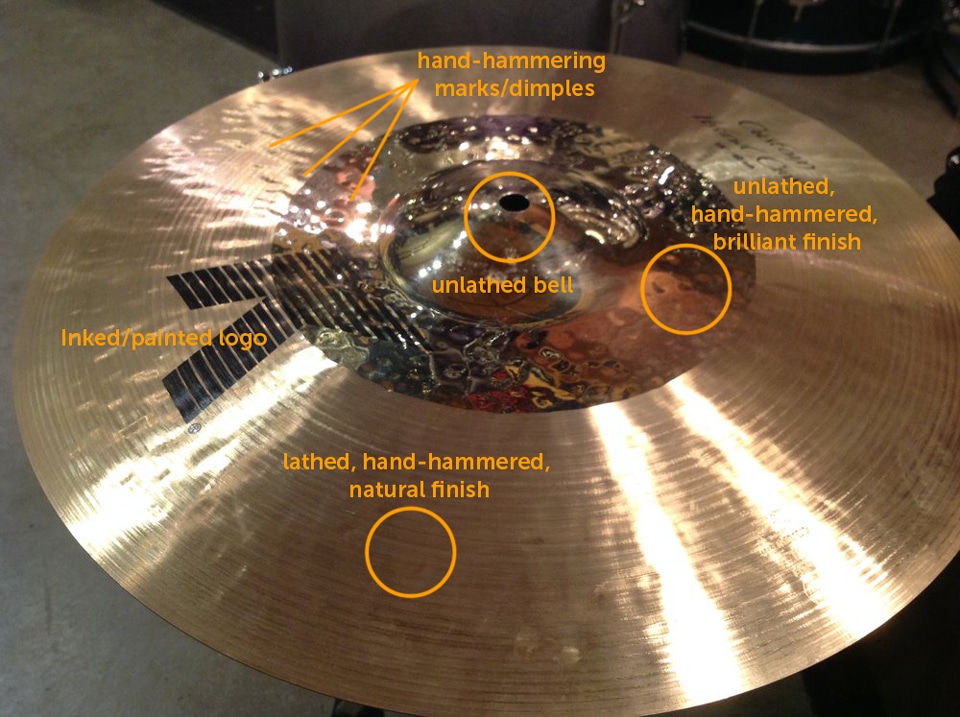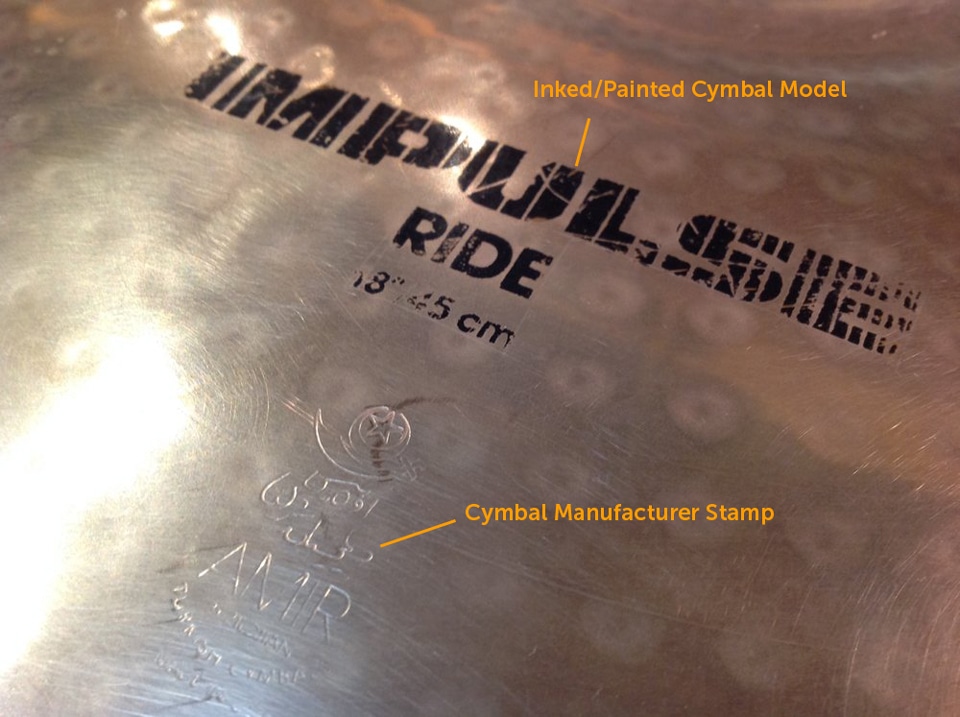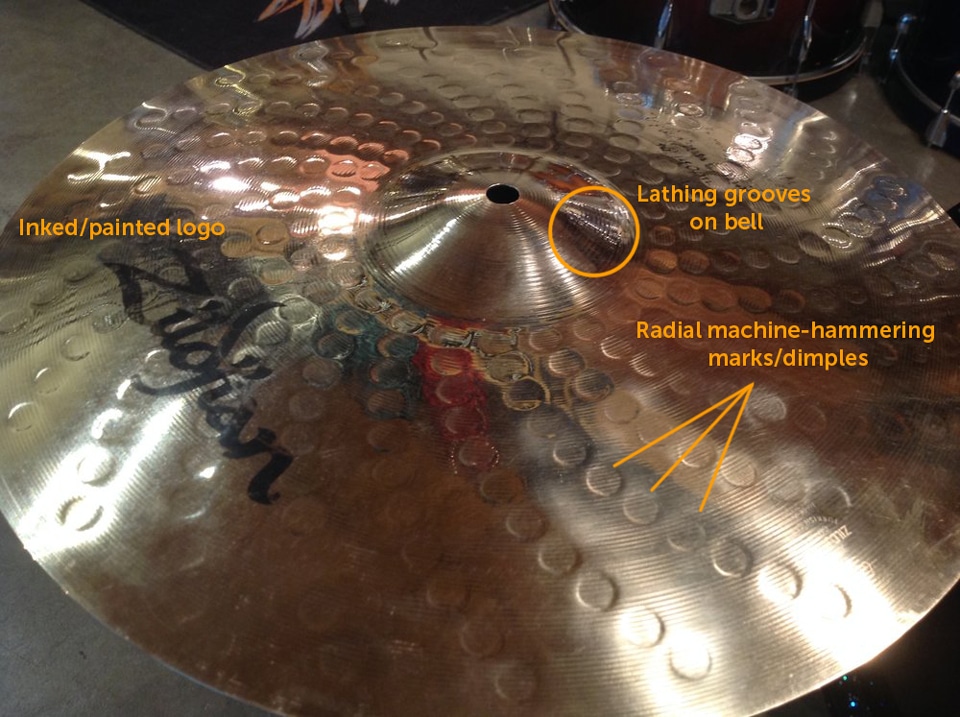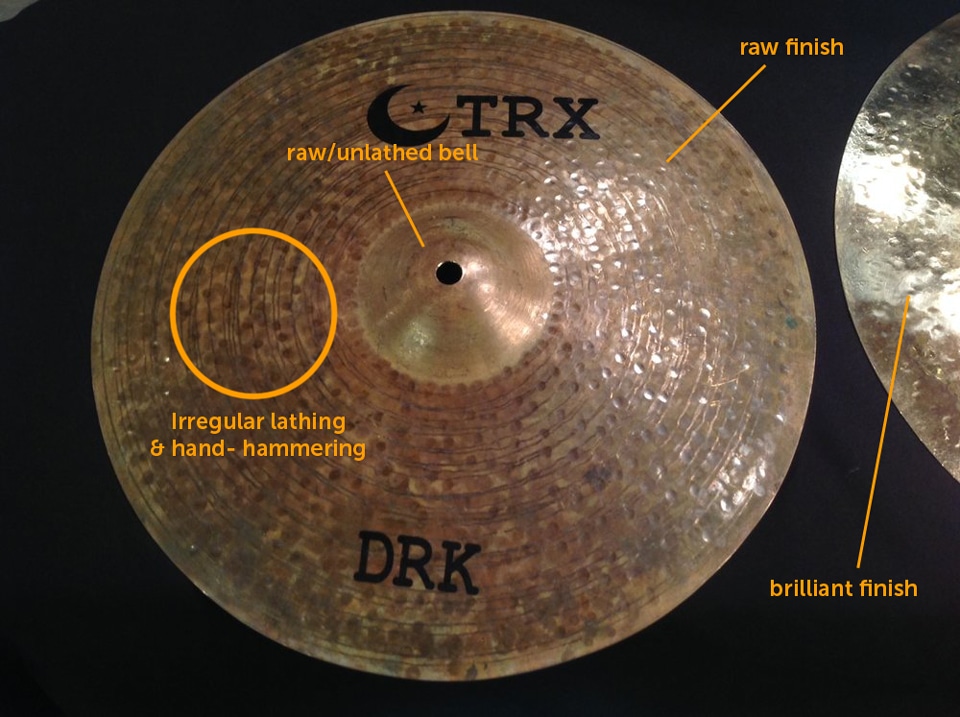So, you've got a great sounding vintage Zildjian K ride cymbal but you have no idea when it was made: how do you date your vintage Zildjian cymbal?
Most people start by searching the internet and guessing at the age of their cymbal based on what they know. What they know is usually based on the biggest marks on the cymbal: the cymbal stamp and cymbal manufacturer logo (if it's not rubbed off). Drummers almost always start with the cymbal stamp since it doesn't rub off.
If you're lucky you'll find a drum or cymbal forum post with a decent photo that matches your cymbal's stamp and logo, and you'll know if you've got a coveted “old K”. More often, you end up lost in a thread with a mix of helpful posts, and some posts that have nothing to do with your cymbal.
If you're lucky enough to find photos of your cymbal model all you have to do is compare your cymbal to the photo right?! Right, if you know what to look for…
Identifying a vintage cymbal: things to look for!
Here's a list of the things that make up a cymbal, focusing on vintage Zildjians. If I missed something get in touch! It might not be totally complete but it's a good starting point if you're totally lost in drum forums full of drum nerd talk.
If you learn with your eyes don't worry, I'll have a gallery after the list with examples.
A quick note, a lot of this info was pointed out to me by Steve Black , whose cymbal research uses statistics to build on the work of Bill Hartrick's original Zildjian stamp timeline.
Cymbal Characteristics:
- Cymbal manufacturer stamp:
- A manufacturer's mark that's usually engraved by laser in the surface of the cymbal or stamped into the molten alloy, especially on vintage cymbals. Laser stamps happened to Zildjians in 1994.
- Cymbal manufacturer ink logo:
- This is the inked/painted manufacturer's logo that usually includes the cymbal's specific model. This varies by brand but for Zildjian the actual “Zildjian” logo wasn't inked until the second-half of the '70's. Some even featured a “Hollow Ink Logo” in the late '70's. Earlier cymbals had models (like “Paper Thin”) inked on them but mostly lost them during cleaning over time.
- Cymbal size:
- Grab your yard stick or tape measure. Most cymbals fall between 13˝ for hi-hats, small crashes and accents and up to 26˝ for the heaviest crashes, larger rides and huge trash/china cymbals. Manufacturer sizes aren't exact, a 20˝ cymbal can actually be slightly larger or smaller than 20˝. Fun fact: Zildjian As were made in huge sizes of 24˝ and 26˝ as far back as 1948! By the way, if you want to get really accurate you can even measure your cymbal bell!
- Cymbal weight:
- Vintage cymbals, Zildjians included, often weighed less than newer cymbals so drummers often give weights in grams (g) as a clue to when they were made. Rough weights for medium lines of cymbal are 2500-2800g for 22˝, 2050-2300g for 20˝ and 1650-1850g for 18˝. If yours is lighter than that you've got a clue that it's an older Zildjian.
- Cymbal centerhole:
- Usually you're looking at size. Manufacturers often change the sizes of cymbal holes. Case in point: in the '50's Zildjian switched from a 7/16˝ hole to 1/2˝, which definitely helps date a cymbal when the labels are gone (or when you can't fit it on your cymbal stand). There's one other thing to look for: grommets. If you see a small metal ring in the centerhole you've got an old marching cymbal.
- Manufacturing process:
- Cymbals are stamped from bronze sheets, hammered or hand-hammered. This can be hard to tell but is more obvious on vintage or boutique cymbals. Cheap cymbals are stamped from bronze sheets with more expensive lines cast from bronze and hammered by machine, giving consistent hammering patterns. More expensive hand-hammered/handmade cymbals (or very old vintage cymbals) are cast and shock-cooled from a higher temperature, which gives a weird shape to the blank and needs more time to hammer back into shape: sounds great but costs more!
- Hammering pattern:
- Related to the manufacturing process. Machine hammered cymbals usually have a “dead on” pattern of dimples or hammer indents. Hand-hammered patterns are a little less precise or straight-up uneven: especially when the cymbals are shock cooled from a high temperature.
- Lathing pattern:
- This is the pattern of rings that go from the cymbal's outer edge in to the centerhole or bell. Most cymbals are lathed, although some are partly lathed with raw (unlathed bells) or no lathing at all (sometimes called blanks).
- Cymbal type:
- Is it a ride, hi hat, crash, china/trash? This one's easy for new cymbals but tough for vintage ones. Once the paint gets rubbed off from cleaning it's easy to mistake a hi hat cymbal for a small crash or even a splash cymbal. Old cymbal catalogs often have the sizes of the cymbals for a given year but if your hi hat is the same size as a crash for that year you have to find another way to identify the cymbal.
- Cymbal finish:
- Again, this one's easier for new cymbals — it's a fancy way of asking if it's shiny (brilliant), normal (natural), or does it look like it just came out of a cave (raw)? Zildjian first advertised brilliant finish cymbals in their catalog in 1970. This can also be misleading since older brilliant finish cymbals have a patina that can look like they had a natural finish. Natural finish cymbals can also be polished to a more brilliant finish.
- Cymbal Holes:
- Sometimes cymbals have holes drilled in them besides the centerhole to change their sound. Example: check out this vintage Zildjian, again thanks to Steve Black.
- Cymbal Sound:
- Identifying a cymbal by sound is tough! It's pretty subjective and requires a lot of experience but can be useful as a last resort. The good news is I've started recording my cymbals including in videos on my YouTube channel, to provide drummers and percussionists the ultimate resource. If you don't know what cymbal you have, check out my videos to help you narrow it down by look and sound. By the way, all the audio and video of my cymbals is professionally recorded for accurate sound!
Confused?!? Here's a gallery with examples of cymbal terms:
I made an illustrated gallery for all you visual learners. These cymbals aren't vintage Zildjian cymbals but have easy to spot visual examples of the cymbal characteristics above.
Check it out and hover over the images for more info on the cymbals:
What we just went over was a lot, but now that you've looked at all your cymbal's characteristics how do you find the year of your cymbal? If you're able to find other pictures of vintage Zildjians that match some of your cymbals' characteristics you can get a good idea of what year or era it was made in. But what if you can't?
So, how do you decide when your Zildjian was made?
The short answer: Steve Black's Zildjian Stamp Timeline
One of the best perks of my job is the people I meet and connect with on a day to day basis. One of those people is Steve Black, a trained statistician researching Zildjian and Paiste cymbals.
A while back Steve contacted me about an 18˝ Avedis cymbal I had on the site which I thought was from the '80's. Turns out I was wrong: the lathing, hammering and “small stamp” meant I had a late 1950's Avedis Zildjian SSB cymbal that came after the earlier '50's small stamps, the SSAs. Thanks again Steve!
Not everyone's lucky enough to have someone doing cymbal research get in touch with them through their website. That's exactly why Steve's been putting his research on his Avedis Zildjian Timeline since 2014. The awesome thing is that he's using “evidence based analysis using appropriate statistical methods” (to quote the man himself) to help clarify the rumors going around on the internet.
Vintage cymbal identification resources
The best vintage Zildjian cymbal identification resource:
In case you haven't figured it out yet, Steve Black's timeline is my favorite “one stop shop” for figuring out when your vintage cymbal was made. Although the other timelines out there are pretty good, no one's using stats the way Steve is.
One reason I'm trying to get people to use his timeline is that it doesn't always come up as high in searches as other ones. It also contains a ton of info so here's some links to get you started:
- Avedis Zildjian small stamps: SSA vs. SSB
- Zildjian's changing centerhole sizes
- Zildjian's different eras of hammering patterns
- Avedis Zildjian bell lathing patterns
Again I can't recommend Steve's work enough!
Other great cymbal identification resources:
- Drum & Cymbal forums: My favorites are Drumforum's cymbal talk and Vintage Drum Forum's vintage cymbal section. If you have a questions, ask them there. Forums are full of drummers who know more than you, just take it with a grain of salt and do your homework.
- Bud Stein's cymbal weight calculator. You can use this to ballpark the weight of your cymbal. This is more useful for drummers with vintage cymbal experience but beginners can compare it to eBay ads for similar cymbals that have weights listed.
- The Hazelshould vintage cymbal and drum museum. Check here to see if you can find a picture of your vintage Zildjian (or Paiste, Bosphorous, Ufip, Sabian, Istanbul Agop or Istanbul Mehmet).
- Jollity's Drum Farm Cymbal Listings. Another resource for vintage Zildjian cymbal pictures.
- eBay searches. This might be obvious, but I've ID'd plenty of cymbals buy searching for the size and make of a vintage cymbal and going through pictures on eBay listings. Never hurts!
Know a resource I'm missing? Let me know and I'll get it on the list! Or drop a comment below…






